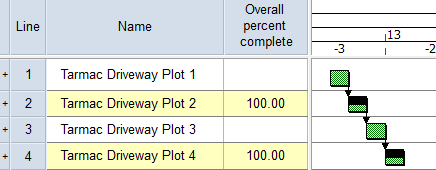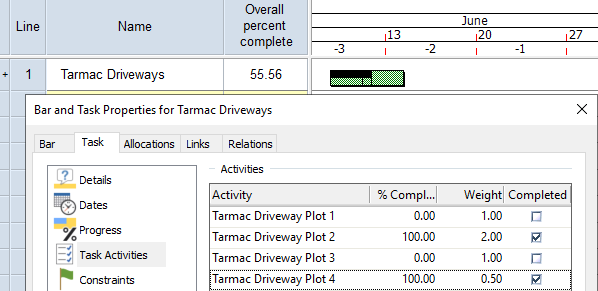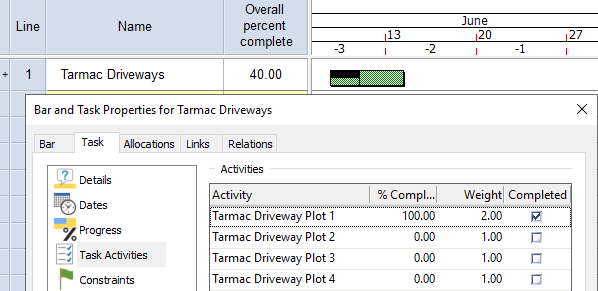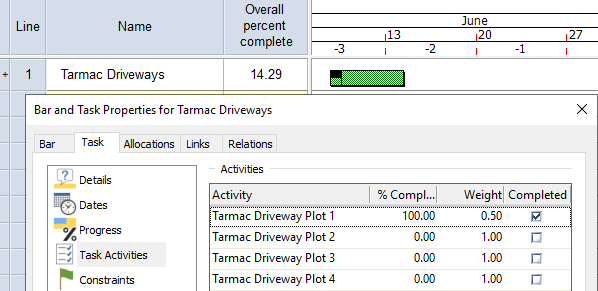Breaking down tasks into smaller steps using task activities
You can use task activities to break down tasks into smaller units of work. Rather than adding additional tasks to a schedule, which adds to its complexity, you can have one task in a project that is broken down into subtasks by task activities.
Task activities also enable you to monitor the progress of work that cannot be easily sequenced. For example, in a new housing development you may have four driveways that need to be tarmacked, where only one drive can be worked on at a time but you do not know the order in which the driveways will be worked on. If you created four individual 'Tarmac Driveway' tasks, one for each driveway, it would be difficult to link them properly, as you would not know the order in which they would be worked on. If you linked them using Finish-to-Start links, you could end up in a situation where a task was completed earlier than one or more of its predecessors.
In the following illustration, four tasks have been linked with Finish-to-Start links. However, two of the tasks have been completed before a predecessor task. This out of sequence progress means that the tasks are linked incorrectly:

Using task activities, you could create a single 'Tarmac Driveways' task that covers all four driveways, with a task activity for each individual driveway. You could then progress the task activities in the order in which the driveways are tarmacked, and the 'Tarmac Driveways' task would be progressed appropriately: the order in which the task activities take place does not matter.
In the following illustration, a single 'Tarmac Driveways' task has been created, with four task activities to represent the work to be carried out on each individual driveway. Two of the task activities have been completed; as the order of task activities does not matter, this does not result in out of sequence progress:

In a simple scenario such as the one above, each task activity will contribute equally towards the progress of the task. For example, if all four driveways were an equal length, they would contribute equally towards the progress of the 'Tarmac Driveways' task. In other scenarios, particular task activities may contribute more, or less, towards the progress of a task. If one of the driveways was four times the length of the other driveways, its task activity would contribute more towards the progress of the 'Tarmac Driveways' task than the other task activities; if another driveway was half the length of the other driveways, its task activity would contribute less towards the task's progress. You can represent this in a project by applying weightings to task activities. A weighting is a factor by which the progress of a task activity should be multiplied to affect its impact on progress of the task.
Each task activity initially has a weighting of '1.00', so initially, each task activity contributes equally towards the progress of the task. You can apply weightings to task activities to increase or decrease their contribution towards task progress. For example, to double a task activity's contribution in comparison to the other activities, you would give it a weighting of '2.00'; to halve its contribution, you would give it a weighting of '0.50'.
In the following illustration, the 'Tarmac Driveway Plot 2' task activity is 100% complete and has a weighting of '2.00', doubling its contribution towards the task's progress; the 'Tarmac Driveway Plot 4' task activity is 100% complete and has a weighting of '0.50', halving its contribution:

If you set a task activity's weighting to zero, it does not contribute towards task progress at all, regardless of the amount of progress on the task activity.
The following calculation shows how task activity weightings affect task progress:
((Activity 1 % Complete x Weight) + (Activity 2 % Complete x Weight) …) / (Total of Weights)
If a task has four task activities, each with a weighting of '1.00', and if one task activity is complete, the task progress is calculated as follows:
(100 x 1) + (0 x 1) + (0 x 1) + (0 x 1) / 4 = 25
The task is therefore 25% complete:

If the first task activity had a weighting of '2.00', indicating that it should contribute twice as much to the progress of the task as the other activities, the task progress would be calculated as follows:
(100 x 2) + (0 x 1) + (0 x 1) + (0 x 1) / 5 = 40
The task would therefore be 40% complete:

If the first task activity had a weighting of '0.50', indicating that it should contribute half as much to the progress of the task as the other activities, the task progress would be calculated as follows:
(100 x 0.5) + (0 x 1) + (0 x 1) + (0 x 1) / 3.5 = 14.29
The task would therefore be 14.29% complete:

As well as being able to create task activities individually, you can use task activity templates to speed up the creation of commonly-used sets of task activities.
You can display a number of task activity-related fields in the spreadsheet and in the bar chart. If you display the 'Task activity names' field in the spreadsheet, you can identify each task's activities without having to view the properties of the task using the Bar and Task Properties dialog.
Using templates to speed up task activity creation